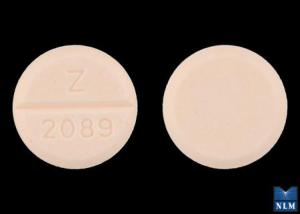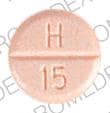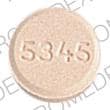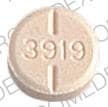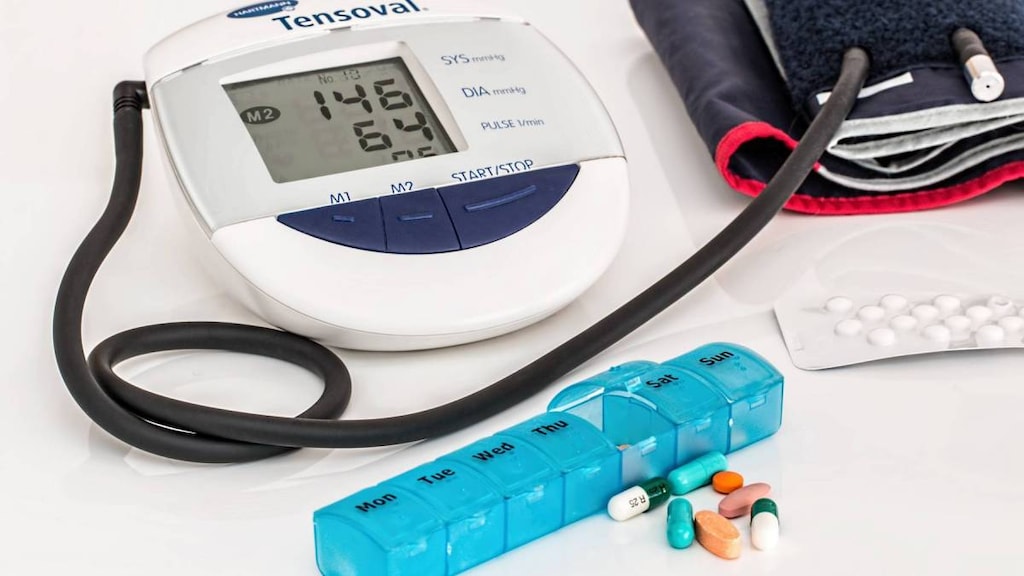Dosage Forms
Excipient information presented when available (limited, particularly for generics); consult specific product labeling. [DSC] = Discontinued product
Capsule, Oral:
Microzide: 12.5 mg [DSC]
Generic: 12.5 mg
Tablet, Oral:
Generic: 12.5 mg, 25 mg, 50 mg
Pharmacology
Mechanism of Action
Inhibits sodium reabsorption in the distal tubules causing increased excretion of sodium and water as well as potassium and hydrogen ions
Pharmacokinetics/Pharmacodynamics
Absorption
Well absorbed; absorption is reduced in patients with CHF.
Distribution
3.6 to 7.8 L/kg.
Metabolism
Not metabolized.
Excretion
Urine (≥61% as unchanged drug).
Onset of Action
Diuresis: Infants: 2 to 6 hours (Chemtob 1989); Adults: ~2 hours; Peak effect: 4 to 6 hours.
Time to Peak
~1 to 5 hours.
Duration of Action
Infants: 8 hours (Chemtob 1989); Adults: 6 to 12 hours.
Half-Life Elimination
~6 to 15 hours.
Protein Binding
~40% to 68%.
Use in Specific Populations
Special Populations: Renal Function Impairment
Hydrochlorothiazide plasma concentration is increased and the half-life is prolonged.
Use: Labeled Indications
Edema: Treatment of edema due to heart failure, various forms of renal dysfunction (eg, nephrotic syndrome, acute glomerulosclerosis, chronic renal failure), or corticosteroid or estrogen therapy. Note: Loop diuretics are typically favored, but hydrochlorothiazide may be used as an adjunctive agent for refractory edema (Brater 2011).
Hypertension: Management of mild to moderate hypertension.
Use: Off Label
Calcium nephrolithiasis, preventionbyes
Data from randomized, double-blind, placebo-controlled studies support the use of hydrochlorothiazide for the prevention of recurrent calcium nephrolithiasis Frassetto 2000, Laerum 1984, Scholz 1982.
Based on the 2014 American Urological Association guidelines for the medical management of kidney stones, hydrochlorothiazide is effective and recommended for the prevention of recurrent calcium stones in patients with high or relatively high urine calcium concentrations.
Diabetes insipidus, nephrogenicc
Data from a limited number of patients studied (case reports) suggest that hydrochlorothiazide may be beneficial for the treatment of nephrogenic diabetes insipidus Constandis 1981, Earley 1962, Meinardi 1997.
Contraindications
Hypersensitivity to hydrochlorothiazide, any component of the formulation, or sulfonamide-derived drugs; anuria
Note: Although some product labeling states this medication is contraindicated with other sulfonamide-containing drug classes, the scientific basis of this statement has been challenged. See “Warnings/Precautions” for more detail.
Canadian labeling: Additional contraindications (not in US labeling): Increasing azotemia and oliguria during treatment of severe progressive renal disease; breast-feeding
Documentation of allergenic cross-reactivity for thiazide-related diuretics is limited. However, because of similarities in chemical structure and/or pharmacologic actions, the possibility of cross-sensitivity cannot be ruled out with certainty.
Dosage and Administration
Dosing: Adult
Calcium nephrolithiasis, prevention (off-label use):
Note: Use for patients with high urine calcium that is not due to hypercalcemia (AUA [Pearle 2014]; Curhan 2019).
Oral: Initial: 25 mg once daily; titrate based on tolerance and urinary calcium levels to usual effective dose of 50 to 100 mg/day in 1 to 2 divided doses (Arrabal-Martín 2016; AUA [Pearle 2014]; Curhan 2019; Frassetto 2000; Laerum 1984; Scholz 1982). Some experts suggest twice-daily dosing for doses >25 mg because of the relatively short half-life (Curhan 2019).
Diabetes insipidus, nephrogenic (off-label use):
Note: Consider for use in addition to a low-solute diet to help reduce polyuria (Irwin 2008).
Oral: 25 mg once or twice daily (Irwin 2008).
Edema, refractory (adjunctive to loop diuretic):
Note: Reserve for patients without hypokalemia (Brater 2019).
Oral: Initial: 25 to 100 mg daily in 1 to 2 divided doses; adjust dose based on response and tolerability; maximum daily dose: 200 mg/day (ACCF/AHA [Yancy 2013]). Some experts favor twice-daily dosing (Brater 2019).
Hypertension (alternative agent):
Note: When a thiazide diuretic is chosen, chlorthalidone or indapamide is preferred (ACC/AHA [Whelton 2018]; Mann 2019). For patients who warrant combination therapy (blood pressure ≥20/10 mm Hg above goal or suboptimal response to initial monotherapy), may use in combination with another appropriate agent (eg, angiotensin-converting enzyme inhibitor, angiotensin II receptor blocker, dihydropyridine calcium channel blocker) (ACC/AHA [Whelton 2018]). However, some experts prefer regimens that do not include thiazide diuretics for combination therapy (Mann 2019).
Oral: Initial: 12.5 to 25 mg once daily; titrate as needed based on patient response up to 50 mg once daily (ACC/AHA [Whelton 2018]; Mann 2019); some experts do not recommend doses higher than 25 mg/day because of greater adverse effects without additional antihypertensive effect (Jamerson 2008; Mann 2019; Ojji 2019).
Dosing: Geriatric
Oral: Initial: 12.5 mg once daily; titrate as necessary in increments of 12.5 mg. Minimal increase in response and more electrolyte disturbances are seen with doses >50 mg daily.
Dosing: Pediatric
Bronchopulmonary dysplasia: Limited data available: Infants: Oral: 3 to 4 mg/kg/day in 2 divided doses (Albersheim 1989; Engelhardt 1989)
Edema (diuresis):
Infants <6 months: Oral: 1 to 2 mg/kg/day in 1 to 2 divided doses; some infants may require 3 mg/kg/day in 2 divided doses; maximum daily dose: 37.5 mg/day
Infants ≥6 months and Children <2 years: Oral: 1 to 2 mg/kg/day in 1 to 2 divided doses; maximum daily dose: 37.5 mg/day
Children ≥2 years: Oral: 1 to 2 mg/kg/day in 1 to 2 divided doses; maximum daily dose: 100 mg/day
Adolescents: Oral: 1 to 2 mg/kg/day in 1 to 2 divided doses (van der Vorst 2006); maximum adult daily dose: 200 mg/day is recommended for heart failure-related edema (ACCF/AHA [Yancy 2013])
Hypertension:
Manufacturer's labeling:
Infants <6 months: Oral: 1 to 2 mg/kg/day in 1 to 2 divided doses; some infants may require 3 mg/kg/day in 2 divided doses; maximum daily dose: 37.5 mg/day
Infants ≥6 months and Children <2 years: Oral: 1 to 2 mg/kg/day in 1 to 2 divided doses; maximum daily dose: 37.5 mg/day
Children ≥2 years: Oral: 1 to 2 mg/kg/day in 1 to 2 divided doses; maximum daily dose: 100 mg/day
Alternate dosing: Infants, Children, and Adolescents: Oral: Initial: 1 mg/kg/day once daily; may increase to maximum daily dose: 3 mg/kg/day or 50 mg/day, whichever is lower (NHBPEP 2004; NHLBI 2011)
Hypercalciuria: Limited data available: Infants, Children, and Adolescents: Oral: Initial: 1 to 2 mg/kg/day in 1 to 2 divided doses; titrate until goal urinary calcium excretion goals reached and symptoms resolve; treatment usually continued for 1 year; usual adult dose: 25 to 100 mg/day (Copelovitch 2012; Santos-Victoriano 1998)
Nephrogenic diabetes insipidus; congenital: Limited data available: Infants, Children, and Adolescents: Oral: 2 mg/kg/day in combination with amiloride; some patients may require 3 mg/kg/day in divided doses. Dosing based on a retrospective descriptive analysis (n=30, age range: 1 month to 40 years) and a pediatric case series (n=4) in patients receiving hydrochlorothiazide in combination with amiloride (Kirchlechner 1999; Van Lieburg 1999). In adults; usual dose range is 25 mg once or twice daily (Irwin 2008).
Extemporaneously Prepared
Note: Compounding instructions and stability based on data for compounding hydrochlorothiazide and spironolactone 5 mg/mL oral suspension
5 mg/mL Oral Suspension (ASHP Standard Concentration) (ASHP 2017)
A 5 mg/mL oral suspension may be made with hydrochlorothiazide tablets and one of three different vehicles (cherry syrup; a 1:1 mixture of Ora-Sweet and Ora-Plus; or a 1:1 mixture of Ora-Sweet SF and Ora-Plus). Crush twenty-four 25 mg tablets in a mortar and reduce to a fine powder. Add 25 mL of the chosen vehicle and mix to a uniform paste; mix while adding the vehicle in incremental proportions to almost 120 mL; transfer to a calibrated bottle, rinse mortar with vehicle, and add quantity of vehicle sufficient to make 120 mL. Label "shake well" and "protect from light." Stable for 60 days (Allen 1996).
Allen LV Jr, Erickson MA 3rd. Stability of labetalol hydrochloride, metoprolol tartrate, verapamil hydrochloride, and spironolactone with hydrochlorothiazide in extemporaneously compounded oral liquids. Am J Health Syst Pharm. 1996;53(19):2304-2309.8893069
Administration
Oral: Administer early in day to avoid nocturia. Take the last dose of multiple doses no later than 6 PM unless instructed otherwise.
Storage
Store at 20°C to 25°C (68°F to 77°F). Protect from light and moisture.
Hydrochlorothiazide Images
Drug Interactions
Ajmaline: Sulfonamides may enhance the adverse/toxic effect of Ajmaline. Specifically, the risk for cholestasis may be increased. Monitor therapy
Alcohol (Ethyl): May enhance the orthostatic hypotensive effect of Thiazide and Thiazide-Like Diuretics. Monitor therapy
Alfuzosin: May enhance the hypotensive effect of Blood Pressure Lowering Agents. Monitor therapy
Allopurinol: Thiazide and Thiazide-Like Diuretics may enhance the potential for allergic or hypersensitivity reactions to Allopurinol. Thiazide and Thiazide-Like Diuretics may increase the serum concentration of Allopurinol. Specifically, Thiazide Diuretics may increase the concentration of Oxypurinol, an active metabolite of Allopurinol. Monitor therapy
Amifostine: Blood Pressure Lowering Agents may enhance the hypotensive effect of Amifostine. Management: When amifostine is used at chemotherapy doses, blood pressure lowering medications should be withheld for 24 hours prior to amifostine administration. If blood pressure lowering therapy cannot be withheld, amifostine should not be administered. Consider therapy modification
Aminolevulinic Acid (Systemic): Photosensitizing Agents may enhance the photosensitizing effect of Aminolevulinic Acid (Systemic). Avoid combination
Aminolevulinic Acid (Topical): Photosensitizing Agents may enhance the photosensitizing effect of Aminolevulinic Acid (Topical). Monitor therapy
Amphetamines: May diminish the antihypertensive effect of Antihypertensive Agents. Monitor therapy
Angiotensin-Converting Enzyme Inhibitors: Thiazide and Thiazide-Like Diuretics may enhance the hypotensive effect of Angiotensin-Converting Enzyme Inhibitors. Thiazide and Thiazide-Like Diuretics may enhance the nephrotoxic effect of Angiotensin-Converting Enzyme Inhibitors. Monitor therapy
Anticholinergic Agents: May increase the serum concentration of Thiazide and Thiazide-Like Diuretics. Monitor therapy
Antidiabetic Agents: Thiazide and Thiazide-Like Diuretics may diminish the therapeutic effect of Antidiabetic Agents. Monitor therapy
Antidiabetic Agents: Hyperglycemia-Associated Agents may diminish the therapeutic effect of Antidiabetic Agents. Monitor therapy
Antipsychotic Agents (Second Generation [Atypical]): Blood Pressure Lowering Agents may enhance the hypotensive effect of Antipsychotic Agents (Second Generation [Atypical]). Monitor therapy
Barbiturates: May enhance the hypotensive effect of Blood Pressure Lowering Agents. Monitor therapy
Benazepril: HydroCHLOROthiazide may enhance the hypotensive effect of Benazepril. HydroCHLOROthiazide may enhance the nephrotoxic effect of Benazepril. Benazepril may decrease the serum concentration of HydroCHLOROthiazide. Monitor therapy
Benperidol: May enhance the hypotensive effect of Blood Pressure Lowering Agents. Monitor therapy
Beta2-Agonists: May enhance the hypokalemic effect of Thiazide and Thiazide-Like Diuretics. Monitor therapy
Bile Acid Sequestrants: May decrease the absorption of Thiazide and Thiazide-Like Diuretics. The diuretic response is likewise decreased. Consider therapy modification
Brigatinib: May diminish the antihypertensive effect of Antihypertensive Agents. Brigatinib may enhance the bradycardic effect of Antihypertensive Agents. Monitor therapy
Brimonidine (Topical): May enhance the hypotensive effect of Blood Pressure Lowering Agents. Monitor therapy
Bromperidol: Blood Pressure Lowering Agents may enhance the hypotensive effect of Bromperidol. Bromperidol may diminish the hypotensive effect of Blood Pressure Lowering Agents. Avoid combination
Calcium Salts: Thiazide and Thiazide-Like Diuretics may decrease the excretion of Calcium Salts. Continued concomitant use can also result in metabolic alkalosis. Monitor therapy
CarBAMazepine: Thiazide and Thiazide-Like Diuretics may enhance the adverse/toxic effect of CarBAMazepine. Specifically, there may be an increased risk for hyponatremia. Monitor therapy
Cardiac Glycosides: Thiazide and Thiazide-Like Diuretics may enhance the adverse/toxic effect of Cardiac Glycosides. Specifically, cardiac glycoside toxicity may be enhanced by the hypokalemic and hypomagnesemic effect of thiazide diuretics. Monitor therapy
Corticosteroids (Orally Inhaled): May enhance the hypokalemic effect of Thiazide and Thiazide-Like Diuretics. Monitor therapy
Corticosteroids (Systemic): May enhance the hypokalemic effect of Thiazide and Thiazide-Like Diuretics. Monitor therapy
Cyclophosphamide: Thiazide and Thiazide-Like Diuretics may enhance the adverse/toxic effect of Cyclophosphamide. Specifically, granulocytopenia may be enhanced. Monitor therapy
Dexketoprofen: May enhance the adverse/toxic effect of Sulfonamides. Monitor therapy
Dexmethylphenidate: May diminish the therapeutic effect of Antihypertensive Agents. Monitor therapy
Diacerein: May enhance the therapeutic effect of Diuretics. Specifically, the risk for dehydration or hypokalemia may be increased. Monitor therapy
Diazoxide: Thiazide and Thiazide-Like Diuretics may enhance the adverse/toxic effect of Diazoxide. Monitor therapy
Diazoxide: May enhance the hypotensive effect of Blood Pressure Lowering Agents. Monitor therapy
Dichlorphenamide: Thiazide and Thiazide-Like Diuretics may enhance the hypokalemic effect of Dichlorphenamide. Monitor therapy
Dofetilide: HydroCHLOROthiazide may enhance the QTc-prolonging effect of Dofetilide. HydroCHLOROthiazide may increase the serum concentration of Dofetilide. Avoid combination
DULoxetine: Blood Pressure Lowering Agents may enhance the hypotensive effect of DULoxetine. Monitor therapy
Fexinidazole [INT]: Thiazide and Thiazide-Like Diuretics may enhance the arrhythmogenic effect of Fexinidazole [INT]. Avoid combination
Herbs (Hypertensive Properties): May diminish the antihypertensive effect of Antihypertensive Agents. Monitor therapy
Herbs (Hypotensive Properties): May enhance the hypotensive effect of Blood Pressure Lowering Agents. Monitor therapy
Hypotension-Associated Agents: Blood Pressure Lowering Agents may enhance the hypotensive effect of Hypotension-Associated Agents. Monitor therapy
Ipragliflozin: May enhance the adverse/toxic effect of Thiazide and Thiazide-Like Diuretics. Specifically, the risk for intravascular volume depletion may be increased. Monitor therapy
Ivabradine: Thiazide and Thiazide-Like Diuretics may enhance the arrhythmogenic effect of Ivabradine. Monitor therapy
Levodopa-Containing Products: Blood Pressure Lowering Agents may enhance the hypotensive effect of Levodopa-Containing Products. Monitor therapy
Levosulpiride: Thiazide and Thiazide-Like Diuretics may enhance the adverse/toxic effect of Levosulpiride. Avoid combination
Licorice: May enhance the hypokalemic effect of Thiazide and Thiazide-Like Diuretics. Monitor therapy
Lithium: Thiazide and Thiazide-Like Diuretics may decrease the excretion of Lithium. Consider therapy modification
Lormetazepam: May enhance the hypotensive effect of Blood Pressure Lowering Agents. Monitor therapy
Mecamylamine: Sulfonamides may enhance the adverse/toxic effect of Mecamylamine. Avoid combination
Methenamine: Thiazide and Thiazide-Like Diuretics may diminish the therapeutic effect of Methenamine. Monitor therapy
Methylphenidate: May diminish the antihypertensive effect of Antihypertensive Agents. Monitor therapy
Molsidomine: May enhance the hypotensive effect of Blood Pressure Lowering Agents. Monitor therapy
Multivitamins/Fluoride (with ADE): May enhance the hypercalcemic effect of Thiazide and Thiazide-Like Diuretics. Monitor therapy
Multivitamins/Minerals (with ADEK, Folate, Iron): Thiazide and Thiazide-Like Diuretics may enhance the hypercalcemic effect of Multivitamins/Minerals (with ADEK, Folate, Iron). Monitor therapy
Multivitamins/Minerals (with AE, No Iron): Thiazide and Thiazide-Like Diuretics may increase the serum concentration of Multivitamins/Minerals (with AE, No Iron). Specifically, thiazide diuretics may decrease the excretion of calcium, and continued concomitant use can also result in metabolic alkalosis. Monitor therapy
Naftopidil: May enhance the hypotensive effect of Blood Pressure Lowering Agents. Monitor therapy
Neuromuscular-Blocking Agents (Nondepolarizing): Thiazide and Thiazide-Like Diuretics may enhance the neuromuscular-blocking effect of Neuromuscular-Blocking Agents (Nondepolarizing). Monitor therapy
Nicergoline: May enhance the hypotensive effect of Blood Pressure Lowering Agents. Monitor therapy
Nicorandil: May enhance the hypotensive effect of Blood Pressure Lowering Agents. Monitor therapy
Nitroprusside: Blood Pressure Lowering Agents may enhance the hypotensive effect of Nitroprusside. Monitor therapy
Nonsteroidal Anti-Inflammatory Agents: Thiazide and Thiazide-Like Diuretics may enhance the nephrotoxic effect of Nonsteroidal Anti-Inflammatory Agents. Nonsteroidal Anti-Inflammatory Agents may diminish the therapeutic effect of Thiazide and Thiazide-Like Diuretics. Monitor therapy
Obinutuzumab: May enhance the hypotensive effect of Blood Pressure Lowering Agents. Management: Consider temporarily withholding blood pressure lowering medications beginning 12 hours prior to obinutuzumab infusion and continuing until 1 hour after the end of the infusion. Consider therapy modification
Opioid Agonists: May enhance the adverse/toxic effect of Diuretics. Opioid Agonists may diminish the therapeutic effect of Diuretics. Monitor therapy
OXcarbazepine: Thiazide and Thiazide-Like Diuretics may enhance the adverse/toxic effect of OXcarbazepine. Specifically, there may be an increased risk for hyponatremia. Monitor therapy
Pentoxifylline: May enhance the hypotensive effect of Blood Pressure Lowering Agents. Monitor therapy
Pholcodine: Blood Pressure Lowering Agents may enhance the hypotensive effect of Pholcodine. Monitor therapy
Phosphodiesterase 5 Inhibitors: May enhance the hypotensive effect of Blood Pressure Lowering Agents. Monitor therapy
Porfimer: Photosensitizing Agents may enhance the photosensitizing effect of Porfimer. Monitor therapy
Promazine: Thiazide and Thiazide-Like Diuretics may enhance the QTc-prolonging effect of Promazine. Avoid combination
Prostacyclin Analogues: May enhance the hypotensive effect of Blood Pressure Lowering Agents. Monitor therapy
Quinagolide: May enhance the hypotensive effect of Blood Pressure Lowering Agents. Monitor therapy
Reboxetine: May enhance the hypokalemic effect of Thiazide and Thiazide-Like Diuretics. Monitor therapy
Selective Serotonin Reuptake Inhibitors: May enhance the hyponatremic effect of Thiazide and Thiazide-Like Diuretics. Monitor therapy
Sodium Phosphates: Diuretics may enhance the nephrotoxic effect of Sodium Phosphates. Specifically, the risk of acute phosphate nephropathy may be enhanced. Management: Consider avoiding this combination by temporarily suspending treatment with diuretics, or seeking alternatives to oral sodium phosphate bowel preparation. If the combination cannot be avoided, hydrate adequately and monitor fluid and renal status. Consider therapy modification
Topiramate: Thiazide and Thiazide-Like Diuretics may enhance the hypokalemic effect of Topiramate. Thiazide and Thiazide-Like Diuretics may increase the serum concentration of Topiramate. Management: Monitor for increased topiramate levels/adverse effects (e.g., hypokalemia) with initiation/dose increase of a thiazide diuretic. Closely monitor serum potassium concentrations with concomitant therapy. Topiramate dose reductions may be necessary. Consider therapy modification
Toremifene: Thiazide and Thiazide-Like Diuretics may enhance the hypercalcemic effect of Toremifene. Monitor therapy
Valsartan: HydroCHLOROthiazide may enhance the hypotensive effect of Valsartan. Valsartan may increase the serum concentration of HydroCHLOROthiazide. Monitor therapy
Verteporfin: Photosensitizing Agents may enhance the photosensitizing effect of Verteporfin. Monitor therapy
Vitamin D Analogs: Thiazide and Thiazide-Like Diuretics may enhance the hypercalcemic effect of Vitamin D Analogs. Monitor therapy
Yohimbine: May diminish the antihypertensive effect of Antihypertensive Agents. Monitor therapy
Test Interactions
May interfere with parathyroid function tests and may decrease serum iodine (protein bound) without signs of thyroid disturbance; may lead to false-negative aldosterone/renin ratio (ARR) (Funder 2016)
Adverse Reactions
Frequency not defined; the occurrence of adverse events are dose related, with the majority occurring with doses ≥25 mg.
Cardiovascular: Hypotension, necrotizing angiitis, orthostatic hypotension
Central nervous system: Dizziness, headache, paresthesia, restlessness, vertigo
Dermatologic: Alopecia, erythema multiforme, exfoliative dermatitis, skin photosensitivity, skin rash, Stevens-Johnson syndrome, toxic epidermal necrolysis, urticaria
Endocrine & metabolic: Glycosuria, hypercalcemia, hyperglycemia, hyperuricemia, hypochloremic alkalosis, hypokalemia, hypomagnesemia, hyponatremia
Gastrointestinal: Abdominal cramps, anorexia, constipation, diarrhea, gastric irritation, nausea, pancreatitis, sialadenitis, vomiting
Genitourinary: Impotence
Hematologic & oncologic: Agranulocytosis, aplastic anemia, hemolytic anemia, leukopenia, purpura, thrombocytopenia
Hepatic: Jaundice
Hypersensitivity: Anaphylaxis
Neuromuscular & skeletal: Muscle spasm, weakness
Ophthalmic: Transient blurred vision, xanthopsia
Renal: Interstitial nephritis, renal failure, renal insufficiency
Respiratory: Respiratory distress, pneumonitis, pulmonary edema
Miscellaneous: Fever
<1%, postmarketing, and/or case reports: Allergic myocarditis, eosinophilic pneumonitis, hepatic insufficiency, malignant neoplasm of lip (Friedman 2012), skin carcinoma (Pedersen 2018), systemic lupus erythematosus
Warnings/Precautions
Concerns related to adverse effects:
- Electrolyte disturbances: Hypokalemia, hypochloremic alkalosis, hypomagnesemia, and hyponatremia may occur. Development of electrolyte disturbances can be minimized when used in combination with other electrolyte sparing antihypertensives (eg, ACE inhibitors or angiotensin receptor blockers) (Sica 2011).
- Gout: In certain patients with a history of gout, a familial predisposition to gout, or chronic renal failure, gout can be precipitated by hydrochlorothiazide. This risk may be increased with doses ≥25 mg (Gurwitz 1997).
- Hypersensitivity reactions: Hypersensitivity reactions may occur with hydrochlorothiazide. Risk is increased in patients with a history of allergy or bronchial asthma.
- Ocular effects: May cause acute transient myopia and acute angle-closure glaucoma, typically occurring within hours to weeks following initiation. Discontinue therapy immediately in patients with acute decreases in visual acuity or ocular pain; additional treatments may be needed if uncontrolled intraocular pressure persists. Risk factors may include a history of sulfonamide or penicillin allergy.
- Photosensitivity: Photosensitization may occur.
- Skin cancer, nonmelanoma: Prolonged use (≥3 years) may increase the risk for squamous cell carcinoma up to 4 times and increase the risk for basal cell carcinoma up to 1.25 times compared to patients not treated with hydrochlorothiazide (Pedersen 2018; Pottegard 2017).
- Sulfonamide (“sulfa”) allergy: The FDA-approved product labeling for many medications containing a sulfonamide chemical group includes a broad contraindication in patients with a prior allergic reaction to sulfonamides. There is a potential for cross-reactivity between members of a specific class (eg, two antibiotic sulfonamides). However, concerns for cross-reactivity have previously extended to all compounds containing the sulfonamide structure (SO2NH2). An expanded understanding of allergic mechanisms indicates cross-reactivity between antibiotic sulfonamides and nonantibiotic sulfonamides may not occur or at the very least this potential is extremely low (Brackett 2004; Johnson 2005; Slatore 2004; Tornero 2004). In particular, mechanisms of cross-reaction due to antibody production (anaphylaxis) are unlikely to occur with nonantibiotic sulfonamides. T-cell-mediated (type IV) reactions (eg, maculopapular rash) are less well understood and it is not possible to completely exclude this potential based on current insights. In cases where prior reactions were severe (Stevens-Johnson syndrome/TEN), some clinicians choose to avoid exposure to these classes.
Disease-related concerns:
- Adrenal insufficiency: Avoid use of diuretics for treatment of elevated blood pressure in patients with primary adrenal insufficiency (Addison disease). Adjustment of glucocorticoid/mineralocorticoid therapy and/or use of other antihypertensive agents is preferred to treat hypertension (Bornstein 2016; Inder 2015).
- Ascites due to cirrhosis: Use with extreme caution or avoid hydrochlorothiazide in the management of ascites due to cirrhosis; may lead to rapid development of hyponatremia when used in combination with spironolactone and furosemide (AASLD [Runyon 2012]).
- Bariatric surgery: Dehydration: Avoid diuretics in the immediate postoperative period after bariatric surgery; electrolyte disturbances and dehydration may occur. Diuretics may be resumed, if indicated, once oral fluid intake goals are met (Ziegler 2009).
- Diabetes: Use with caution in patients with prediabetes or diabetes mellitus; may see a change in glucose control.
- Hepatic impairment: Use with caution in patients with severe hepatic dysfunction; in progressive or severe liver disease, avoid electrolyte and acid/base imbalances that might lead to hepatic encephalopathy/coma.
- Hypercalcemia: Thiazide diuretics may decrease renal calcium excretion; consider avoiding use in patients with hypercalcemia.
- Hypercholesterolemia: Use with caution in patients with moderate or high cholesterol concentrations; increased cholesterol and triglyceride levels have been reported.
- Hypokalemia: Use with caution in patients with hypokalemia; correct before initiating therapy.
- Parathyroid disease: Thiazide diuretics reduce calcium excretion; pathologic changes in the parathyroid glands with hypercalcemia and hypophosphatemia have been observed with prolonged use; should be discontinued prior to testing for parathyroid function.
- Renal impairment: Cumulative effects may develop, including azotemia, in patients with impaired renal function. Avoid in severe renal disease (ineffective).
- Systemic lupus erythematosus (SLE): May cause SLE exacerbation or activation.
Concurrent drug therapy issues:
- Drug-drug interactions: Potentially significant interactions may exist, requiring dose or frequency adjustment, additional monitoring, and/or selection of alternative therapy. Consult drug interactions database for more detailed information.
Special populations:
- Surgical patients: If given the morning of surgery, hydrochlorothiazide may render the patient volume depleted and blood pressure may be labile during general anesthesia.
Dosage form specific issues:
- Propylene glycol: Some dosage forms may contain propylene glycol; large amounts are potentially toxic and have been associated with hyperosmolality, lactic acidosis, seizures and respiratory depression; use caution (AAP 1997; Zar 2007). See manufacturer's labeling.
Monitoring Parameters
Blood pressure, dizziness, lightheadedness; sodium, potassium, BUN, creatinine; skin to assess for photosensitivity, skin cancer
Hypertension: The 2017 Guideline for the Prevention, Detection, Evaluation, and Management of High Blood Pressure in Adults (ACC/AHA [Whelton 2017]):
Confirmed hypertension and known cardiovascular disease or 10-year atherosclerotic cardiovascular disease (ASCVD) risk ≥10%: Target blood pressure <130/80 mm Hg is recommended.
Confirmed hypertension without markers of increased ASCVD risk: Target blood pressure <130/80 mm Hg may be reasonable.
Diabetes and hypertension: The American Diabetes Association (ADA) guidelines (ADA 2019):
Patients 18 to 65 years of age, without ASCVD, and 10-year ASCVD risk <15%: Target blood pressure <140/90 mm Hg is recommended.
Patients 18 to 65 years of age and known ASCVD or 10-year ASCVD risk >15%: Target blood pressure <130/80 mm Hg may be appropriate if it can be safely attained.
Patients >65 years of age (healthy or complex/intermediate health): Target blood pressure <140/90 mm Hg is recommended.
Patients >65 years of age (very complex/poor health): Target blood pressure <150/90 mm Hg is recommended.
Pregnancy
Pregnancy Considerations
Hydrochlorothiazide crosses the placenta (Beerman 1980).
Maternal use may cause fetal or neonatal jaundice, thrombocytopenia, or other adverse events observed in adults.
Use of thiazide diuretics to treat edema during normal pregnancies is not appropriate; use may be considered when edema is due to pathologic causes (as in the nonpregnant patient); monitor.
Chronic maternal hypertension is associated with adverse events in the fetus/infant. The risk of birth defects, low birth weight, premature delivery, stillbirth, and neonatal death may be increased with chronic hypertension in pregnancy. Actual risks may be related to duration and severity of maternal hypertension. Diuretics are considered second-line therapy for treating chronic hypertension in pregnancy (ACOG 203 2019).
The treatment of edema associated with chronic heart failure during pregnancy is similar to that of nonpregnant patients. Use of thiazide diuretics may be considered but use with caution due to the potential reduction in placental blood flow. Patients diagnosed after delivery can be treated according to heart failure guidelines (ESC [Bauersachs 2016]; ESC [Regitz-Zagrosek 2018]).
Patient Education
What is this drug used for?
- It is used to treat high blood pressure.
- It is used to get rid of extra fluid.
- It may be given to you for other reasons. Talk with the doctor.
Frequently reported side effects of this drug
- Constipation
- Diarrhea
- Dizziness
- Lack of appetite
- Nausea
- Vomiting
- Headache
Other side effects of this drug: Talk with your doctor right away if you have any of these signs of:
- High blood sugar like confusion, fatigue, more thirst, hunger, passing a lot of urine, flushing, fast breathing, or breath that smells like fruit.
- Fluid and electrolyte problems like mood changes, confusion, muscle pain or weakness, abnormal heartbeat, severe dizziness or passing out, fast heartbeat, more thirst, seizures, loss of strength and energy, lack of appetite, unable to pass urine or change in the amount of urine produced, dry mouth, dry eyes, or nausea or vomiting.
- Kidney problems like unable to pass urine, blood in the urine, change in amount of urine passed, or weight gain.
- Pancreatitis like severe abdominal pain, severe back pain, severe nausea, or vomiting.
- Lupus like rash on the cheeks or other body parts, sunburn easy, muscle or joint pain, chest pain or shortness of breath, or swelling in the arms or legs
- Shortness of breath
- Dark urine
- Yellow skin
- Chills
- Sore throat
- Burning or numbness feeling
- Bruising
- Bleeding
- Severe loss of strength and energy
- Skin changes
- Vision changes
- Eye pain
- Signs of a significant reaction like wheezing; chest tightness; fever; itching; bad cough; blue skin color; seizures; or swelling of face, lips, tongue, or throat.
Note: This is not a comprehensive list of all side effects. Talk to your doctor if you have questions.
Consumer Information Use and Disclaimer: This information should not be used to decide whether or not to take this medicine or any other medicine. Only the healthcare provider has the knowledge and training to decide which medicines are right for a specific patient. This information does not endorse any medicine as safe, effective, or approved for treating any patient or health condition. This is only a brief summary of general information about this medicine. It does NOT include all information about the possible uses, directions, warnings, precautions, interactions, adverse effects, or risks that may apply to this medicine. This information is not specific medical advice and does not replace information you receive from the healthcare provider. You must talk with the healthcare provider for complete information about the risks and benefits of using this medicine.

